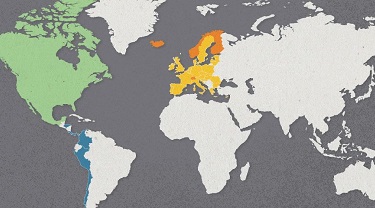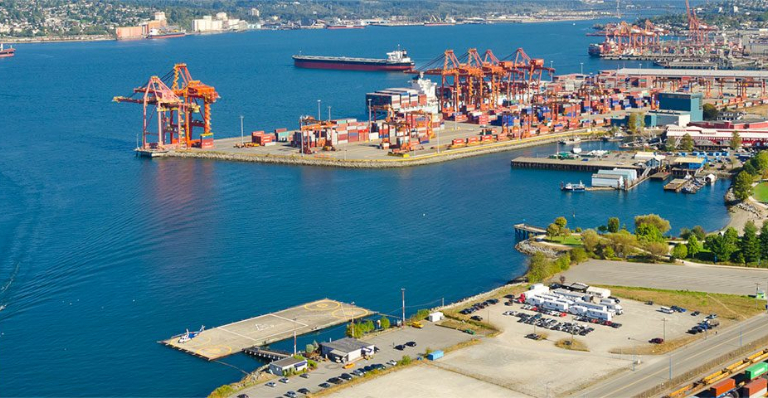Canadian businesses looking to expand into new markets have a distinct competitive advantage in countries governed by one of Canada’s 14 free trade agreements (FTAs). By removing tariffs on goods and services, FTAs open doors of opportunity around the globe for Canadian companies in various sectors. Canada’s top 10 best countries to do business are those with which Canada has comprehensive FTAs. Canada has also established foreign investment promotion and protection agreements (FIPAs) with a number of countries, making them the best countries for Canadian investment.
The U.S., Canada’s largest and closest trading partner, tops the list of best countries for Canadian business and investment. The history of successive trade agreements between Canada and the U.S., and the opportunities they have created for firms on both sides of the border, is an example of how free trade agreements contribute to economic growth, underscoring the importance and purpose of international trade agreements.
Canada and the U.S. have enjoyed one of the most unique and prosperous bilateral relationships in the world, since 1989 when the Canada-U.S. Trade Agreement was brought into force. That initial FTA was superseded by NAFTA in 1994, which broadened free trade to include Mexico.
One of NAFTA’s major achievements has been the elimination of tariffs on most goods across a number of sectors. NAFTA has also been credited with the liberalization of regulations affecting things like investment and cross-border trade in services, making the U.S. one of the best countries for Canadian businesses to invest. Through NAFTA, North American businesses have better access to materials, technologies, investment capital and talent.
Canada-U.S. trade by the numbers under NAFTA:
- U.S. companies purchased 72.6% of Canada’s total exports in 2016, valued at $453.7 billion. Canada imported $348.5 billion worth of U.S. goods and services, representing 52.6% of all imports to this country.
- In 2016, Canada was the top destination market for exports from 32 of the 50 U.S. states and the second largest market for nine other states.
- More than 15% of all American goods and services exported to the world are bought by Canadians
Renegotiating NAFTA: Will the U.S. remain the best country for Canadians to do business?
Renegotiation of NAFTA started in August 2017. Rules of origin, agricultural trade and supply management, intellectual property regulations, arbitration panels and currency manipulation are all on the table.
Even with a NAFTA overhaul, it’s unlikely the U.S. status as one of the best countries for Canadian business will change. Canada remains an important source of inputs, resources and materials for a number of U.S. industries. Canadian business and investment could not be replaced easily without significant disruption to U.S. supply chains and higher costs for U.S. companies and consumers. It’s likely that, in the longer term, the Canada-U.S. trade relationship will remain intact. The NAFTA discussions will undoubtedly result in revisions to the agreement, but some of those changes may represent positive developments for Canada.
For practical advice on how your company can do business in the U.S., read the Trade Commissioner Service’s (TCS) Exporting to the U.S. Guide.
When companies think of NAFTA, they often think of the U.S.. But, as as Canada’s third-largest trading partner, Mexico’s significance to NAFTA and as top country for Canadians to do business, cannot be overlooked. Bilateral trade between Canada and Mexico has grown significantly since NAFTA’s implementation. Through NAFTA, Canadian companies have found substantive opportunities for business growth and investment in Mexico.
Canada’s trade with Mexico accounts for $8.8 billion or 1.4% of total Canadian exports. Trade between the two nations has increased more than sevenfold since the implementation of NAFTA more than two decades ago.
For Canadian companies, there are many areas of opportunity to do business in Mexico including aerospace, agri-food, automotive, information and communications technology, mining as well as oil and gas.
Visit EDC’s Mexico country page as well as the Trade Commissioner Service’s Mexico website for further details on opportunities available for Canadian companies and why Mexico is one of the best countries for Canadian business.
Four of Canada’s top 10 export markets are part of the European Union (EU) – the UK, Germany, Netherlands and France. The recent provisioning of the Canada-European Union (EU) Comprehensive Economic and Trade Agreement (CETA) opens up free trade to 28 countries, approximately 500 million people and represents $22 trillion in economic activity.
The largest free trade deal since NAFTA, CETA will create enormous trade and investment opportunities for Canadian companies by eliminating 98.4% of tariffs on all non-agricultural Canadian goods entering the EU. This will create many new growth opportunities for small and medium-sized Canadian exporters.
CETA is comprehensive. Beyond the removal of tariffs on goods and services, CETA demands consistency of rules governing product standards and professional certifications required by both Canada and the EU.
For a comprehensive analysis of CETA, visit EDC’s CETA resource page or the Global Affairs CETA info web page.
Brexit – U.K’s exit from the EU
In March 2019, Britain is scheduled to leave the 28-country European Union. How the U.K. will relate to the EU after its departure will depend on the results of the exit negotiations and how much can be preserved of the existing trade relationship. Until the March deadline passes, however, Britain will remain a full EU member and CETA’s rules will continue to govern Canada-U.K. trade.
Both Canada and the U.K. have voiced their intentions to seek out a bilateral trade deal once the U.K. exits the EU.
Canada’s first free trade agreement in the Asia-Pacific region, the FTA with South Korea, came into force in 2015. It offers Canadian exporters preferential access to the world’s 11th-largest economy and the fourth-largest in Asia. South Korea is also a gateway to regional and global value chains, which may help Canadian companies become increasingly competitive in the Asia-Pacific area.
During the agreement’s first year, Canada saw increased exports across several sectors, especially in agri-foods, fish and seafood, forestry products and industrial goods.
It is projected that the agreement will boost Canada’s GDP by $1.7 billion and increase Canadian exports to South Korea by more than 30%.
Canada’s major exports to South Korea in 2016 included:
- Mineral ores
- Fuels
- Metals
- Wood pulp and products
- Machinery
- Agri-food, fish and seafood
For more information visit EDC’s South Korea resource page or Global Affairs’ dedicated website to the South Korea Free Trade Agreement.
The Canada-Chile FTA came into force in 1997. It covers both goods and services, and investments. A 2017 update addresses sanitary and phytosanitary measures, government procurement, technical barriers to trade and investment rules. Bilateral merchandise trade between Chile and Canada has more than tripled since the agreement came into force, growing to $2.4 billion in 2016.
Canada’s major exports to Chile in 2016 included:
- Machinery
- Fuels and oils
- Pharmaceuticals
- Plastics and plastic products
- Agri-food commodities and products
For more information visit EDC’s Chile Country Info resource page in addition to information on the Canada-Chile Free Trade Agreement on the Global Affairs’ website.
The Canada-Colombia FTA came into force in 2011. It reduces or eliminates tariffs on most Canadian exports to Colombia. It also ensures equitable treatment for Canadian investment in the country. Key opportunities for Canadian businesses in Colombia include agricultural commodities, paper products, heavy equipment, mining, oil exploration, printing and education.
Canada’s major exports to Colombia in 2016 included:
- Agri-food commodities and products
- Machinery
- Paper and paper products
- Fertilizers
- Pharmaceuticals
For more information visit EDC’S Colombia resource page or Global Affairs’ dedicated website to the Colombia Free Trade Agreement.
In force since 2008, this FTA is supported by accords on environmental and labour cooperation. It eliminates tariffs on 95% of current Canadian exports to Peru.
Canada’s major exports to Peru in 2016 included:
- Agri-food and food products
- Machinery
- Motor vehicles
- Fuels and oils
- Paper and paper products
For more information visit EDC’S Peru resource page or Global Affairs’ dedicated website to the Peru Free Trade Agreement.
Canada’s initial free trade agreement with Israel came into force in 1997 and was updated in 2003. Canada’s FTA with Israel is a goods-only agreement with no investor provisions. It eliminates tariffs on all industrial products manufactured in Canada and Israel and on a selection of agricultural and fisheries products. Negotiations to expand the scope of the agreement are ongoing.
Canada’s major exports to Israel in 2016 included:
- Aircraft and aircraft parts
- Machinery
- Paper and paper products
- Scientific and technical instrumentation
- Pharmaceuticals
For more information visit EDC’S Israel resource page or Global Affairs’ dedicated website to the Israel Free Trade Agreement.
Canada’s FTA with Costa Rica was implemented in 2002 with a focus on trade in goods. It does not cover cross-border trade in services, financial services, investment or government procurement. Negotiations are in progress to eliminate agricultural and industrial tariffs, increase market access and broaden the agreement to other areas.
Canada’s major exports to Costa Rica in 2016 included:
- Agri-food commodities and products
- Machinery
- Fertilizers
- Scientific and technical instrumentation
- Plastics and plastic products
For more information visit EDC’S Costa Rica resource page or Global Affairs’ dedicated website to the Costa Rica Free Trade Agreement.
The Canada-Ukraine FTA was adopted in 2017. It eliminates tariffs on a wide range of goods and also addresses non-tariff barriers.
Ukraine is one of the best countries for Canadian businesses and exporters in agriculture and agri-food, manufactured goods, agricultural machinery, aerospace components, plastics and cosmetics. Canada’s major exports to Ukraine in 2016 included:
- Fuels and oils
- Agri-food and food products
- Machinery
- Pharmaceuticals
- Scientific and technical instrumentation
For more information visit EDC’S Ukraine resource page or Global Affairs’ dedicated website to the Ukraine Free Trade Agreement.
Other resources:
Tariff Finder Canada: The Canada Tariff Finder is a free tool that allows Canadian exporters to check the tariff applicable to a specific good in a foreign market. The focus is on countries where Canada has a Free Trade Agreement (FTA) in place.
Global Affairs: Canada’s Free Trade Agreements: A searchable database of Canada’s FTAs and FIPAs.
Canada’s Trade Commissioner Service: As part of Foreign Affairs, Trade and Development Canada, the Canadian Trade Commissioner Service helps Canadian companies and organizations succeed globally.






